REC Foundation is a none-for-profit organization,established in United States in 1997. from 2001--2010, We found and organized "REEL CHINA" Documentary tour in United States, the venues included: Yale University , Columbia University, New York University, New York Public Library, Stanford University, University of California Los Angeles and ZKM Karlsruhe Germany, etc. Now we'll focus on organizing art exhibition and cultural exchanges.
Don't wanna be here? Send us removal request.
Text

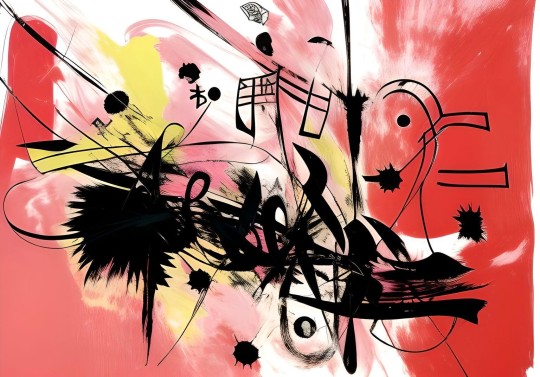


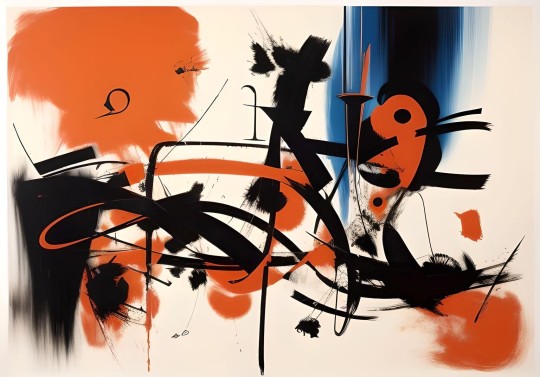
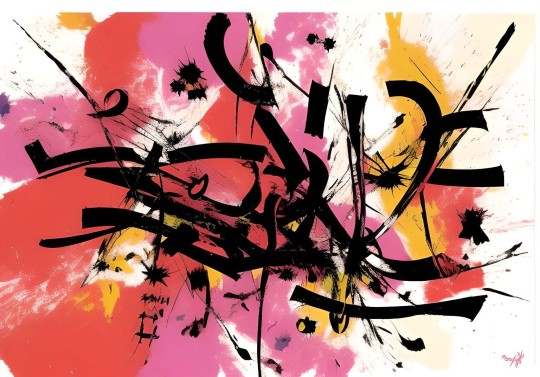

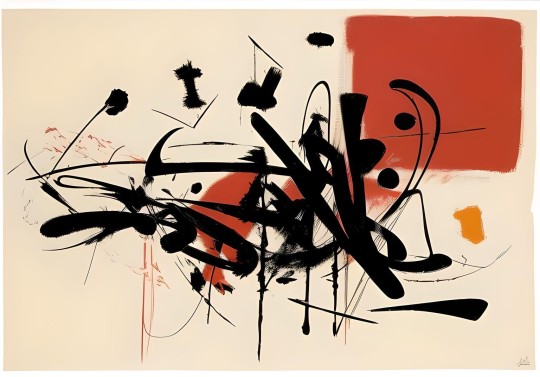

The all works were created in New York in 2022, interested friends can communicate with me! Thank you. I'm PJ
0 notes
Text
水墨的空间历程
平杰
水墨艺术自上世纪八十年代经历了剧烈的变革,开启了现、当代水墨画的蔚然大观。人们不注意的是,水墨的概念本身也开始了裂变,不仅在平面形式上开疆扩土,与此同时,一些艺术家不甘心于在二维平面的展示方式,把水墨艺术迈向了空间,形成了空间水墨(装置)。

广曜:水墨行为 1985 北京
最初的作品走向空间,媒材还是与笔墨纸有关,如1985年,在北京大学艺术节上,广曜用画在长条布上的水墨画包扎自己,展示行为艺术;

吴山专: 今天下午停水 1986 杭州
1986年,吴山专 的大字报形式“今天下午停水”;
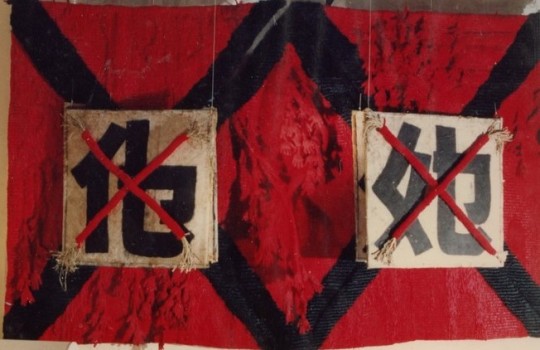
谷文达 : 他X她 1987 杭州
1987年,谷文达的混合材料装置“他X她”;这些作品,基本上是挪用平面作品用空间方式展示。
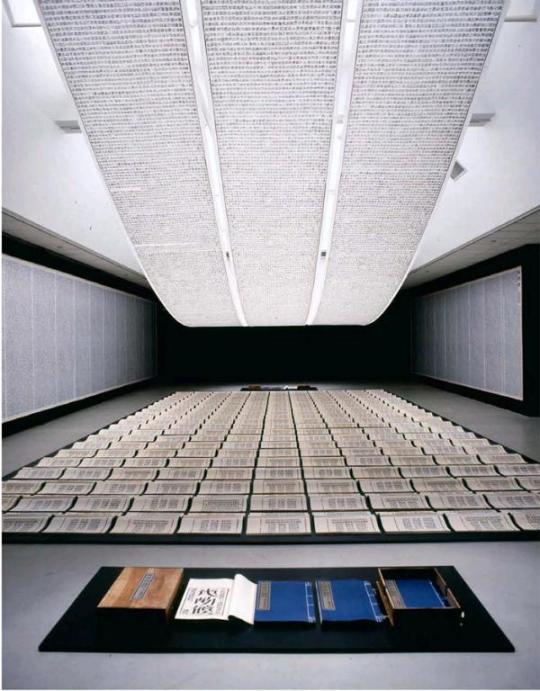
徐冰:天书 1987 北京
直至1987年,徐冰的“天书��装置出现。才显示出正真意义上的空间水墨装置。“天书”,无论在作品观念上,装置方式上,还是制作精度上大大提升了空间水墨的维度。同时也确立了空间水墨作为一个独立形态的开端。
空间水墨的概念是什么呢?它是水墨精神在空间的生成形态,是不同材料的跨越组合,是水墨观念的视觉转换。通过材质上的突破和扩延,印证和归纳水墨精神多维存在的方式,以确立当代水墨艺术的新空间。
水墨艺术走向空间,并非是某个人的创造,它是汇入当代艺术潮流的必然趋势。水墨能够走向空间,还有其文化的特殊性。水墨,从字面上解,可分为水与墨,水为自然属性,墨为文化属性;水墨画是画种名称,水墨或水墨精神则是一个美学观念。这个审美属性,始终是品鉴水墨画的重要指标。当水墨走向空间,其笔墨属性未必还在,但审美观念随着时代的发展不断变化与时俱进。其核心-东方哲学的宇宙观始终是其精神支撑与隐形存在。
九十年代以后,空间水墨开始了一个大的发展,其中1992年,王南冥的“字球组合”,1993年,谷文达的“联合国系列”(美国),1994年,广曜的“风景”(德国),徐冰的“新英语书法”(美国·行为互动),1995年,陈箴的“圆桌”(美国),宋冬的“水写日记”(行为),1996年,陈箴的“日咒”(美国),王天德的“水墨菜单”,宋冬的“印水”(行为),1997年,蔡国强的“文化大混浴”(美国·装置与行为),张键君的“足迹”(日本·装置与行为)1998年,蔡国强的“草船借箭”(美国),1999年威尼斯双年展,黄永砯的“一人九兽”(意大利)等。这些作品大多在国际场合展示,其主题充分展示了作品的国际视野与当代艺术思维,并被共识与公认。究其原因,1,完全超越了地域观念 2,作品所指是全球化的现象 3,“墨”元素的包融性、开放性与宇宙观。
中国美学极少将“物”作为一个纯客观对象的存在,它总是将主体感悟、宇宙生命与主题精神赋予一体,在中国审美经验中,物我是能够互相感应、互为一体的。在西方人看来雷同的一山一石一花一草中,中国艺术家能不断地赋予其不同的生命���验和精神。在东方哲学中,金、木、水、火、土是一个命题,是物质世界也是精神世界,是材质的组合与对应,也是精神、命理与环境的和谐形式;是互补与轮回,是相生又相克,是人与自然的空间构成。

陈箴:圆桌 1995 纽约
陈箴的“圆桌”,造型大小不同的椅子被嵌入在一张大圆桌里,造成了一种不能入座的悖论,圆满之下的不平等与不落地…对联合国一些表面形式的质疑;
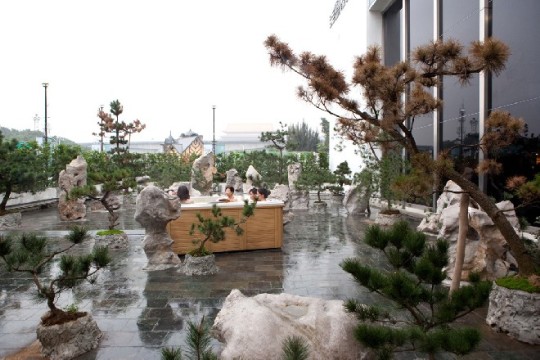
蔡国强:文化大混浴 1997 纽约
在蔡国强的“文化大混浴”里,用各种植物配置的中药池和充满风水布局的空间,转换为文化大融合的主题;

徐冰:新英语书法 1998 美国
在徐冰的“新英语书法”课堂里,把英语植入颜体楷书的书写程序,却诉说着英语世界的故事…,
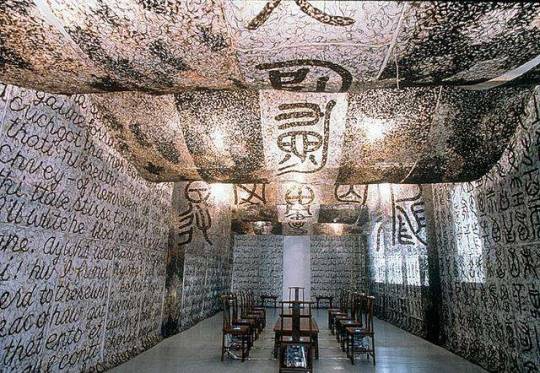
谷文达:联合国 1998 纽约
谷文达的“联合国系列”则用不同肤色的头发呈现种族平等问题;

黄永砯 : 一人九兽 1999 威尼斯
黄永砯在1999年威尼斯双年展上的“一人九兽”,挪用了《山海经》中的神兽形象柱子,穿越在西方建筑中…作为对现有的主导性世界秩序的替代方案的一种象征。(侯瀚如语)
这些作品虽然具有“墨”文化的元素,其主题却是全球性的关注点,为不同文化、宗教、种族的人们所共认与共识。
随着高科技时代到来,材料的物性已经起了根本的变化,虚拟、影像、生物、声光;液态、气态、生态、味态等似乎都已成为空间构成的元素,书写的方式也起了根本变化,它是否能生成当代水墨精神呢?水墨精神是否应该具有新的含义呢?水墨精神是否能进入新的视觉领域呢?
2000年以来,艺术家开始注重自身对材料的体验与转换,社会与文化的宏大叙事渐渐消退,对媒材的拓展令空间水墨的语言与语境更为丰���。不谨是装置,一些建筑设计、室内设计也出现空间水墨的韵味。
艺术家首先是对材料“物性”的空间把握,从物的自然属性--物的构成属性--物的精神属性;去构建与生成一个水墨的审美空间。以多维度空间作为创作切入点,借助当代艺术所独有的表现手段和创作形式,对水墨精神做出全新的诠释。
材料的所指是多意性、象征性,同时又能转换的。它在空间互相关联,与人相息。在传统中国园林与建筑空间中,材料总是与天象、方位、风水等诸多的空间元素中生成境界。中国园林追求的是造境,从来不是纯粹居所,它集水墨精神、文人情怀、生命感悟于一体,构成一个特定的审美空间。
在不同材质组合的装置中,对“符号”与“物性”的转换,是基本要求,去除以往对中国符号的简单挪用,突显对物--材质的个人体验,突显材质在空间的文化沉淀,突显材质的意义转换,突显装置结构的水墨精神。
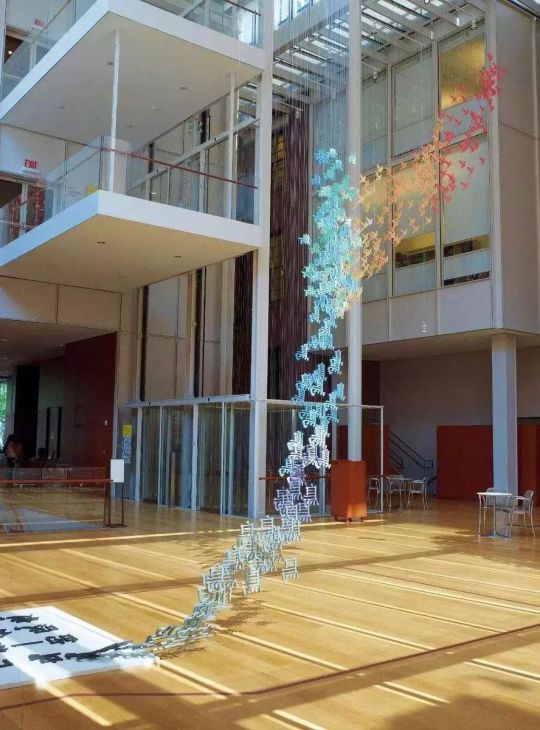
徐冰:鸟飞了 2001 华盛顿
如2001年,徐冰的“鸟飞了”(美国),一部中国文字演变史,从象形文字到印刷体,被串联成一个“腾飞”的空间装置。
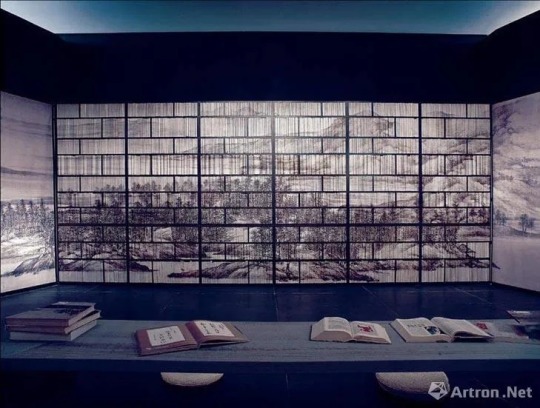
吕胜中:山水书房 2003 威尼斯
2003年,第50届威尼斯双年展,吕胜中的“山水书房”,全部用现成书脊图案拼装出一个壮观的山水书房。
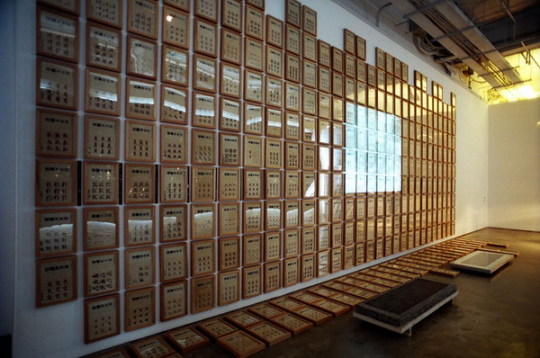

管怀宾 : 叩印兰亭 2004
2004年,管怀宾的“吟游的诗人”和“叩印兰亭”(日本): “叩印兰亭”把324个字的“兰亭序”,请人各临其中一字,然后再集字刻石,再现一部概念上的《兰亭序》,把一气呵成的法书分解成社会化网络化的群体行为,这种集约式的合成映射出现代社会的内在逻辑。
2004年,戴光郁的“山水·墨水·冰水”(德国),
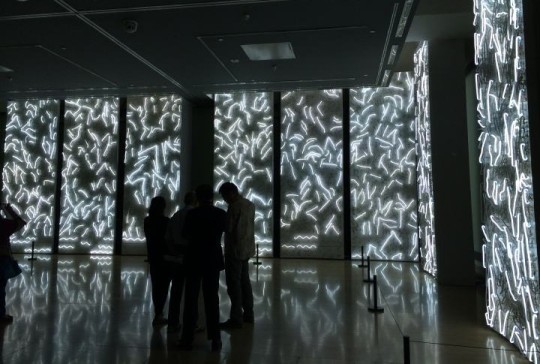
申凡:向黄宾虹致敬 2006
2006年,申凡的“向黄宾虹致敬”,用霓虹灯管构建山水线条长卷,超乎了人们的寻常经验。
2007年,张键君的“过程的瞬间-上海石库门计划”,把环境融入作品。2009年,张羽的“指印”行为,肉身与材质的互动映照等。

蔡国强 : 海市蜃楼 2011 多哈
2011年,蔡国强首次中东个展“海市蜃楼”在多哈举行,开幕式的烟花真正上演了一次空中“泼墨”。
在2012年《“墨”测高深》-首次空间水墨主题展览中,空间被赋予三种形态,它由三个空间理论构成,即物理空间、材质空间和精神空间。
由于材质的多样性与丰富性,对艺术家提供了多渠道的展示方式与空间构成。《“墨”测高深》展览中,引人注目的是每个作品材质转化的精神空间;蒋正根“稻田里的故事”的生物水墨世界;张键君“过程的瞬间—吟石戏水”之“逝水”世界; 陈友桐“物的墨”之微生物世界;申凡“山水-9210”之凝固的钢筋水泥世界;广曜的“点像数化网络世界”;桑火尧“幽园中的那些传说”之寓意与象征世界等。
2013年,在喜玛拉雅美术馆开馆展“意象”展中,空间水墨再一次汇聚:
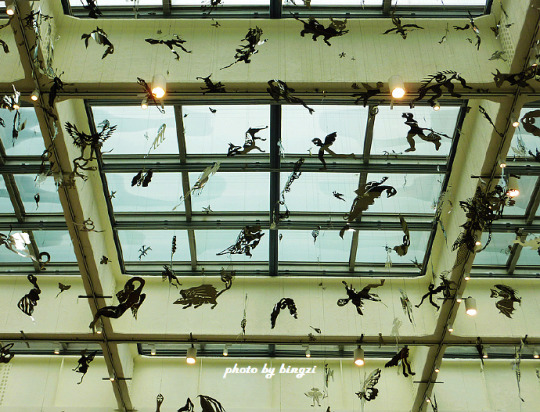
孙良:新山海经 2013
空中,是孙良的“新山海经”,几百个不锈钢片雕刻的奇禽异兽相约天庭,银光闪烁,随气流飘逸,宛如一个神仙派对。
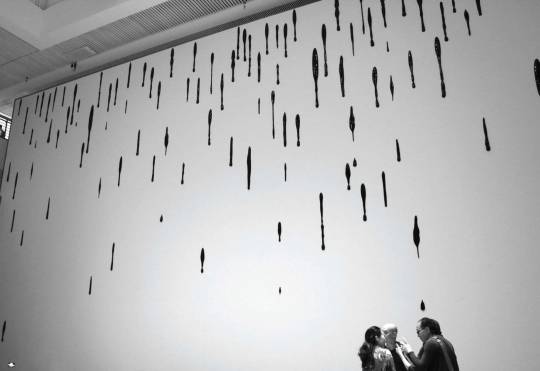
刘建华:迹象 2013
刘建华的“迹象”,大大小小的陶瓷“墨点”冲天而降,布满十四米的高墙,既庄严又诙谐!
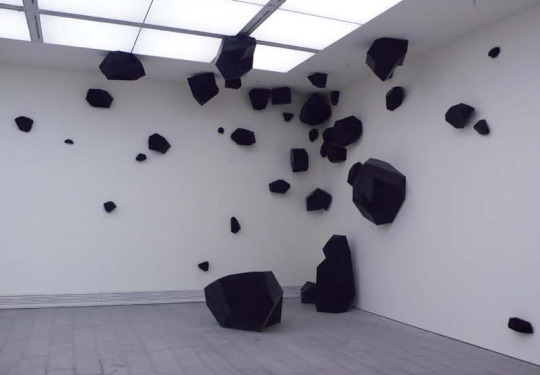
丁乙:滚石 2013
丁乙的“滚石”扶摇直上,如同进入失重空间,轻重倒错,似入浮游世界,挤堆墙梢;
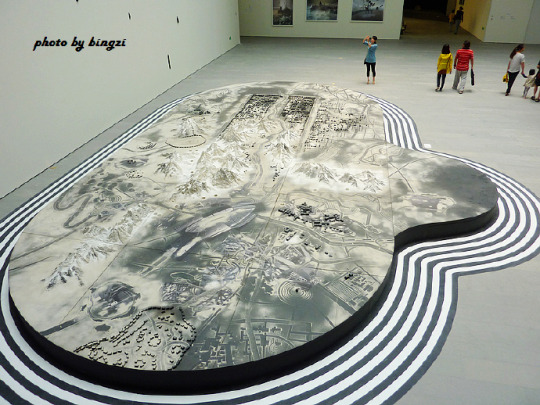

袁顺:零计划 2013
地表则有袁顺的“零计划”,人们俯视山脉岩石烟云翻腾,似星际穿越,观时空变幻。

蒋正根、马运灿:石之观化
另一边,蒋正根、马运灿的“石之观化”,静如禅宗庭院,明月照松间,溪水石上流;

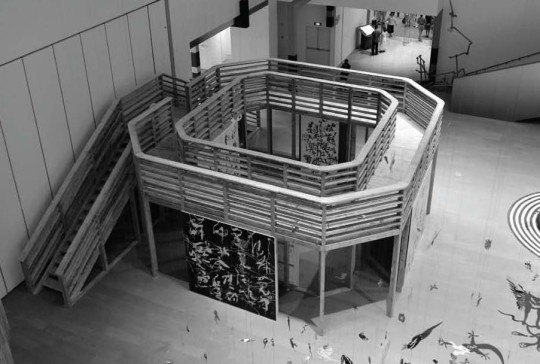
郑国谷 : 无有来去去又来,去来本是无去来 2013
郑国谷设计了一个禅宗意味的楼台,曰:“无有来去去又来,去来本是无去来”;

戴光郁 :风水 2013
戴光郁的冰上书写“风水”,飘逸如云,转眼即空。
宋冬的“金木水火土”方阵(装置与行为),观众课参与在石盘上清水书写,体验瞬逝感觉。

又一山人 : 凡非凡 2013 香港
香港艺术家又一山人的户外移动装置“凡非凡”,摇一叶扁舟,载一丘绿土与松树,欲去装点江边的林立高楼,等等。

徐冰:桃花源的理想一定要实现 2013
2013年,徐冰的“桃花源的理想一定要实现”,在英国伦敦展出,生在一个迷乱纷争的世界,作者仍然坚守他的理想国。
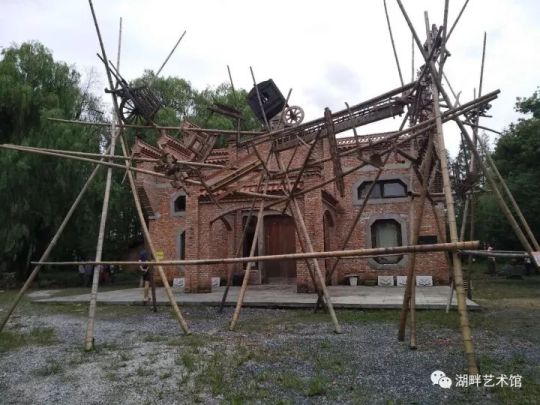
胡项城:宋应星的雕塑 2017 淀山湖畔
2017年,胡项城的“宋应星的雕塑”,把农耕时代的实物农具转换成一个纪念碑式的装置,对应了这个“回归”展的主题与田野展地。

张羽:上水 2016 五台山
2014年至2017年,张羽实施系列“上墨”“上水”“上酒”计划,把空间水墨做到了超然于物质至上,有着“明心见性”的精神境界。
在空间水墨中,整个作品结构的思维均已改变,装置艺术取消了地域性,媒材成为共享资源,装置语言的国际化成为作品流通的重要前提,艺术家的关注点、个性和文化的基因成为作品的标志。装置作品虽然是材质的组合构成,但最终的所指往往都是形而上的精神空间。精神性的载体通过占有空间的物呈现于空间。这样对材料的思维与体验就变得十分重要,材料成为水墨观念的传播媒介,空间则是实现精神性的最终形式。
0 notes
Text
“墨”测高深 A New Spirit in Ink
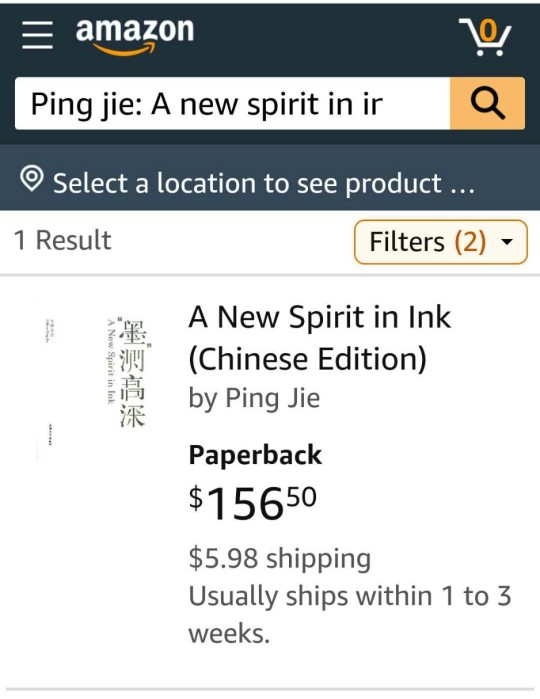
PING JIE & GUANG YAO / 平杰 & 广曜
P. 最近看到《"墨″测高深》在美国Amazon线上销售,令我想起2012年的这个大展。一个展览是否有意义,主要看它提出了什么?拓展了什么?填补了什么?深化了什么?
这个展览的意义在于提出了“空间水墨”这个新概念。即: 水墨不等于水墨画,水墨也不等于水加墨,水墨既是媒材,又是独特的审美观念。这也是东方艺术独有的现象。空间水墨不是���水墨材料做装置,而是任何材料任何方式在三维空间中生成的具有"水墨″精神的作品。把水墨精神的审美形式体现在空间中,水墨发展到今天的地步,空间的传达是否是它的最后边界?
G. “墨”测高深展第一次系统地把水墨现象放在三维空间中来观看,请注意我说的是“水墨现象”而不是水墨画。这种全景观式的空间推演,大大地扩充了作为文人画传统的水墨语汇和语境。展览中出现的各种新材料与语义的有效贯通,证明水墨画作为一种古老的特别画种具有自我延续和更新重置(reset)的机能,更重要的是,这个展览还呈现出新的维度,我叫它为第四维度,就是水墨新的时代精神。这才是你说的边界,最后的底线。
P. 后来的纽约大都会"水墨艺术″展把水墨的外衍更加放大,几乎包罗了所有中国当代艺术。我在纽约听到,"水墨艺术″成为一个大概念,包括了所有与中国文化符号沾上边的当代艺术。但这种泛水墨概念恰恰使水墨精神消解掉了,扼杀掉了。把水墨艺术变成标签式的物品。“墨测高深”
一开始就不提倡这种标签式作品,强调媒材的多元性与时代性。注重观念的更新、材料的转换与空间的呈现,我们座标的水墨精神是具有中国哲学境界的融入当代艺术趋势的新精神。 在材料和形式可以无所不包的当代艺术趋势中,精神座标更是凸现人的存在的一个重要标志。事实上,水墨走向空间,在1980年代巳经出现,今天它包容的内涵和媒材更深更广。
G. 文化部把“墨”测高深作为年度优秀展推荐是有依据的。图画进入三维空间是世界趋势,水墨画当然不会缺席,问题是随着多媒体和材料的介入,并不是因为它们本身的诉求,而是水墨画的当代转型和其传统精神的时代承接已经无法回避这样的现实:平面个人笔迹必然走向空间隐喻,这就是我前面说的水墨现象。从1985年我在北大的水墨行为展示开始,发生了一系列类似的水墨事件。(附图: 北大,棋,闻鸡起舞)这些场景化的事件和之后的装置作品反过来会影响纸本水墨,我想两者是同向平行的。你疑虑水墨现象因为个人笔墨的退场,是否会对中国传统图画中以个人笔墨为绝对准则的型态发起挑战,这个问题是语言的直接还是间接表达的事情。应当这样看,笔墨是经由媒介质料的入场以另一种形式展现出来,而且会持久地引入新的可能。
P. 水墨能够走向空间,一个重要原因是水墨不仅是一个媒材概念,它还是一种东方思想系统中的文化精神。 “墨”测高深的艺术家们都自觉地或直觉地呈现了这个精神维度。他们用不同材料不同方式取代笔墨,在装置作品中展示出强烈的水墨精神风貌。当我们再来回顾这个展览,发现这些作品不约而同都有一个共同特点;即对"时间”的关怀。

申凡的“山水-9210”,居然把股市曲线与钢筋水泥合为一体,每个部件就是一个时间刻度,整个装置就是跌跎起伏的时间线。

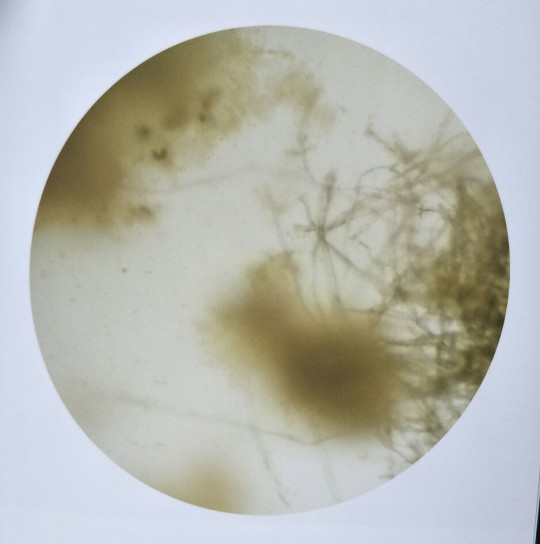
蒋正根/庄亚伦的“稻田里的故事”,在水稻田上架起屏幕,上演了隐匿在生物作用下的“稻田水墨”,无论是草履虫,还是水稻,都是真实的(在地时间)生物活动,整个作品,就是生物的时间线。
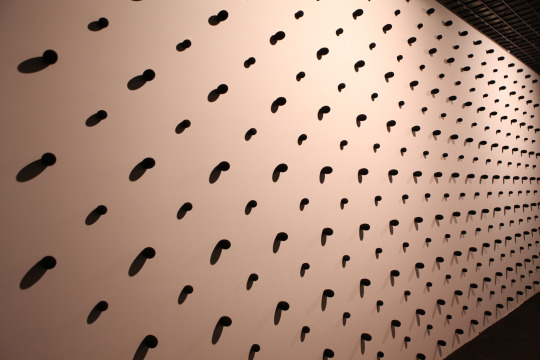
广曜的“点像数化网络空间推图”,是当今社会的全息图景,时间不是线性而是网状的铺张,点是所有链接物的代码,不管是虚拟空间或实体空间。

管怀宾的航拍影像“回流”,壮观的钱江大潮,大自然的时间节奏。“子在川上曰:逝者如斯夫,不舍昼夜。”对时间驻足,感悟生命价值。

张健君的“过程的瞬间:吟石戏水”集观念、行为、影像、装置于一体,虚拟水,真实水,书写水,不断显现,不断消失。时间就是永逝的瞬间。

陈友桐的“物的墨”,宣纸上堆起的微生物小丘,等待现场一个月的繁洐变幻,时间就是它留下的斑迹。

芭芭拉的“风·雅·墨”,流水(动)、墨池、枯树,水是自然,墨为文化,二者交融,源远流长。

王天德的“数码—碑”,苏州老宅古砖墙与古碑(实物),宣纸原作。古与今的时间琏接。

高入云的“水幕”,循环滚动的水幕般动线,如瀑布般飞流直下、周而复始。
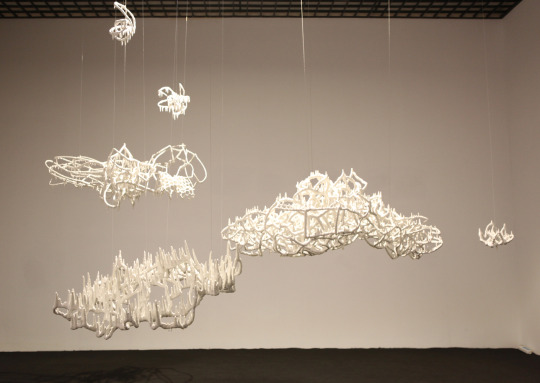
周阳的“流”,如钟乳石,滴浆造型,"滴″的流程,视频中“嘀嗒嘀嗒”着时间节拍。
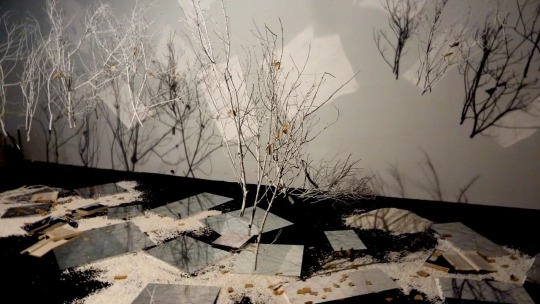
桑火尧的“幽园中的那些传说” ,故园、残卷、碎片。枯枝,旧梦,蓦回首,斜阳依旧。
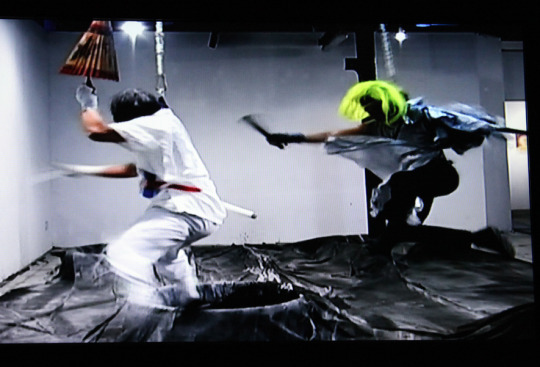
香港226小组,两位古今武士以悬吊形式在墨池上方对空舞剑,以动漫行为作超时空表演。
秦毅等的“墨之韵“,新媒体古琴音乐与人互动产生随机同步墨影作品。

郑国谷、陈再炎、孙庆麟的“松园”,罩上石蜡的松树、餐桌,记录了过往的沉醉与喧哗。
如果缺失这些三维空间的时间轴,也就失去作品的内在力量。水墨精神不是流派,不是语言形式,也不是偶然现象。它随着社会的发展,材料多元与空间认知,隐含在缤纷多姿的空间作品中,是艺术家自身寻找精神维度的自然诠释。
G. 也许正是这样,使不少人感到平面上的笔墨已经不足以表达了,不得不另辟蹊径,获得更大的自由度,甚至不惜走向三维空间。一些人放弃平面笔墨经营在三维空间中一展身手,未必一定成功,要看作品有否内在力量,给观众的感受是否到位和发生共鸣来判断,不是所有在空间中的实物堆积就是好的,空洞肤浅的材料堆积比比皆是。空间水墨艺术实验经过上世纪众多艺术家的投石问路,在今天看来,这条路已经打通:拆除纸上运笔和空间感悟的边界,扩大水墨语言的时空广度和深度,把各种具有水墨倾向的关怀放在同一个平台上互相竞技,重新审视各种媒介之间的对话;而这种纷杂多变的热闹场景,它们之间的互相吸引和排斥,它们对观众眼球的力争,它们面对时代挑战的不同应变,正是水墨艺术精神承前启后深远广阔的内核所在。
P. 水墨精神能够超越时代,在当代空间作品中还能感知,正是在于它的宇宙观,它的三位一体的感知形式,当人的认知发生变化,其时空的内涵也随之更新。在中国哲学中,时间、空间、人是一体的,关注时间,就是显示空间与人的存在。“天地四方曰宇,往古来今曰宙。”(见《释文》《尸子》)这是中国哲学的宇宙观,宇是空间,宙是时间。空间水墨的时间性是与作品有关联的实时记录,时间具有“在地性”。
G. 宇宙中的物体正在互相远离而去,这个现象虽然在人类的现代时段才被观察到,相信五千年前的状况未必不同,而我们的祖先却把宇宙中的一切看成是互相关联的整体。在此前提下所萌发的整体网络系统世界观,是中国思想中最具智慧的内核,也是我们东方人特有的,在与世界上其它文明相处时不可被替代的精神基因。而且,从太极易卦到河图洛书,都呈现出我们对这种宇宙观进行模拟的热诚,这就是推图。同时也证实了推图为中国思想表达方式的独特品相。确信人不是宇宙空间存在的唯一目的,实为中华文明虽几经磨难但仍然不失其聚变活力,不断开拓的天赐。如果人类有一天被迫离开这个已经居住了数万年的地球向宇宙中的其它星球迁移(往往是因为人类自身的行为所致),无疑中国人仍将带着这个依然鲜活的“卜”在那里生存下来。思想推图传统在当今全球信息化时代,又承载着对此作出社会学意义的推演功效;即个体终端与全体网络系统的关链在空间中的推演。这就要求它穿透宇宙生成学与社会学之间的隔阂,打通图象观看(平面)和空间真实体验(立体)之间的边界,达到新思想系统层面的全息通觀世界实相原型。
0 notes
Video
youtube
Qin Feng: The Movement of Qi
Curator: Ping Jie
Eastover Projects
0 notes
Text
LI GANG: SEQUENCE VARIATION
Press Release / Eastover Projects / Curator: Pingjie Zhang ,
Li Gang's attitude towards art is nothing short of distinctive. His art hints at a “relax” attitude that seems to have run through the start of his journey in experimental ink to present, as well as a growing sense of “non-action”. In facing the tangibly taxing subject of contemporary art with the concept of “non-action”, the artist's strategy equates that of giving a double negative answer. Li's personality and temperament underline his work. “Non-action” does not refer to the absence of action. Through his reflection on the nature and value of art, his experiment of ink has entered an abstract state to an extent from the start. In the same vein as Western abstract drawing, his work seeks to build a universe of painting outside of the world of tangible images, giving an “autonomous existence” to painting.
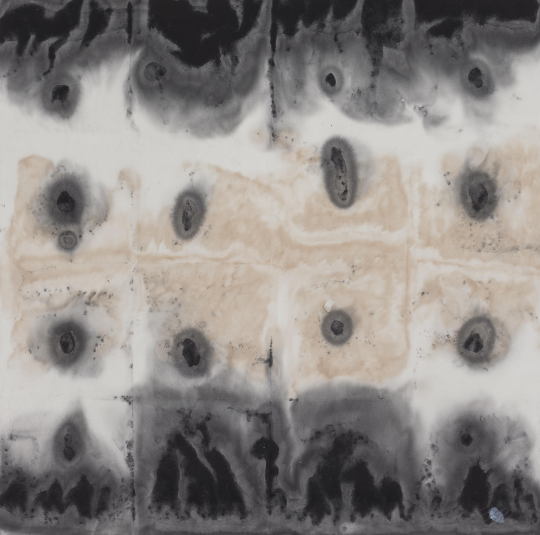
1 note
·
View note
Photo

LI GANG: SEQUENCE VARIATION
Opening: 6:30-8:30pm Aug 10, 2019
Venue: Eastover Eco-Village
1-866-264-5139. 430 East St. Lenox.MA 01240
www.eastover.com https://recfd.tumblr.com
'
0 notes
Text
THE EXCELLENT MOVEMENT OF ART Achille Bonito Oliva / Curator; Critic; Founder of Transavant- garde Movement
继续阅读
1 note
·
View note
Text
THE EXCELLENT MOVEMENT OF ART Achille Bonito Oliva / Curator; Critic; Founder of Transavant- garde Movement
The classicism of Qin Feng lies in the unscandalisedacceptance of the intelligent fortuity of life, the availability of the universe. Art becomes the place where the artist for malisessuch principles, incorporating them into the artwork traversed by a geometry pivoting on asymmetry that produces dynamism and not staticity. The Chinese artist always works on families of artworks, since they derive from matrixes capable of multiplying themselves into complementary yet different forms, between abstraction and figuration. In this way the concept of design takes on a new meaning, no longer evoking a moment of magnificent precision, but rather one of open testing, albeit guided by a method built on practice and exercise in execution. The method naturally recalls the need for a constant and progressive parameter, anchored to the historical awareness of a context dominated by the principle of technique.
Technology develops productive processes anchored to standardisation, objectivity and neutrality. From such principles, American pop art and Chinese neo-pop art are the iconographic confirmation and representation of a philosophical materialism and a vital consumption spawned by the urban culture of the big cities. These are constituent principles of a different mentality from that of Qin Feng’s abstraction which is built on a profound and highly subjective idea of diversity. In this sense, the Chinese artist is an immune carrier of an art that can produce difference through the creation of forms that use standardisation, objectivity and neutrality differently in a fertile manner: a manner capable of filtering the imagination of a mass society pervaded by the supremacy of technique and emptied of subjectivity and spirituality by this technique itself.
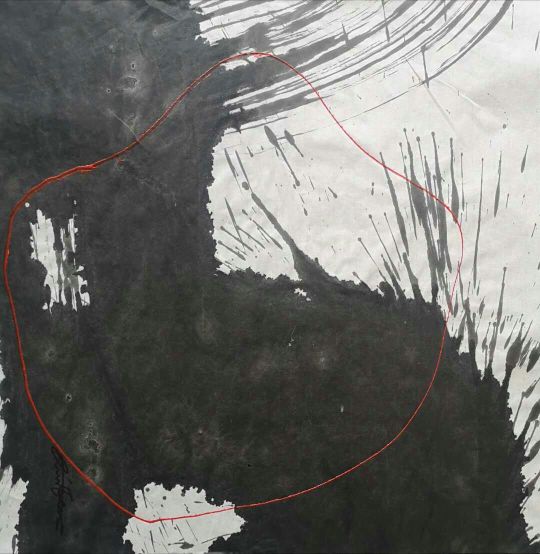
But in Chinese painting this emptying is not seen as a loss, as it could appear to a late Humanist or Marxist mentality. On the contrary,it leads to a new human anthropology operating through a metabolism of modular reason. However, this does not signify symmetric repetition but asymmetric multiplication, that is, the application of new rules of intelligent fortuity as opposed to undifferentiated chaos.
Intelligent fortuity means man’s ability to accept discontinuity without succumbing to the despair of incapable rationality. The acceptance is generated by the loss of pride in Western logo centrism which encompasses the patient analytics of the oriental world and moves pragmatically, not in battle trim but with openness towards the world. A globalised world where influences between East and West are reciprocal. Zen has influenced American action-painting, European painting and Cage’s music. American pop art has stimulated Chinese figurative work towards the representation of urban reality. It has done so through a static vision of space.
Qin Feng’s work comprises trust in the ethical reason for art, capable of melding linguistic forms appropriate to its own time. The difference lies in the diverse notion of utopia employed by Western artists active in the late capitalistic society of the late twentieth century. Here what prevails is a positive concept of utopia, which is also present in all the historic avant-gardes of our century. It is, indeed, the idea of the power of art and of its language to reverse its own order upon the disorder of the world. The Western rational optimism, albeit in this case creative, in the ability to affect the process of transformation of the world and of social behaviour.
Qin Feng what emerges is a concept of healthy negative utopia, understood as awareness of the impossibility of art to establish an order beyond its own confines. In a sense the ethic of doing prevails over the politics of creating. An ethic that, moreover, identifies a process of focusing the conceptual and executive process of art. In fact, the artist conceives the forms in a solitary manner and then sometimes delegates the execution. This does not meanthe abandonment of the product or the pride of the artist favouring the moment of conception over that of realisation. On the contrary, it posits the possibility of art to open up to exchange and social contact, eliminating the conventional ritual of the invention, the sacredly obscure moment of the realisationof the artwork which has accompanied much contemporary art. Asymmetry also signifies the principle of collaboration and of collective contact.
Here there is a prevalence of what can be figured, a medley of abstract and figurative, whereas art instead tends to underscore forms, to give body even to geometry. Indeed, these two-dimensional or three-dimensional forms are always concrete linguistic realities, statements of a mental order that is never repressive and closed but fertile and unpredictable. In any case, the forms germinate and multiply with unexpected angles that unfurl the potential of a new eroticism. These forms always display a domestic monumentality, which does not allude to the arrogance of the American skyscraper or the rhetoricof sculpture.

Qin Feng’s work is anti-rhetorical, inclined to restore an interior and mental human condition. For this reason it rejects the Renaissance perspective that American pop art and the Chinese neo-pop art use to represent urban reality. Here the vision is anti-perspective: this abstract painting looks at the world from different angles with a gaze always in movement which creates dynamic images.
This does not mean waging a conventional war on the forms existing in reality; on the contrary it means creating a linguistic sphere of analysis and synthesis. The analysis is produced by the possibility of testing the germination of these families of forms, and the synthesis by the delicate strength of the whole unfolding before our eyes. The germination of the asymmetric geometry also produces an original execution of theart work which completely opens up its possibility of existing to social solidarity. In this way the art resumes its ancient status as concrete work.
The works of the Chinese artist are sites of confluence, places to think and act where design and realisation concretely entwine to establish a system of production not only of forms but also of social behaviour.
According to Klossowski“every experimental initiative demands a delirious, extremely clear interpretation” and the relation between the artist and language is based on the consideration that it represents the total reality to be addressed, the starting point from which one can move to experiment a possible laceration capable of forging a new articulation.
The strength of the Chinese artist lies in the ability to construct a landscape of forms that, in their own alteration, do not intend to measure themselves against the visual codes of reality. He has no resentment towards the things that surround him, but –armed with an indispensable sense of omnipotence –employs artistic creation as a tool to construct an independent universe, separated from the things themselves.
In this way, his images do not childishly transgress the canons of harmony, proportion and symmetry. They do not constitute alandscape of purely sentimental iconographic resentment, mirroring the cold landscape surrounding man. In relation to language Qin Feng places himself in the condition of a builder who intends to use his own resources to create a world as the will and representation of his own vision.
He employs the clear delirium of a creative process which is entirely based on the economy of purely abstract language.
The artworks possess a plastic tension that is inscribed on the two-dimensional canvas or in the three-dimensional space with the strength and necessity of its own internal proportions. A sense of construction attends the artwork, which is always created with the awareness of a whole that has to support itself though a formal self-sufficiency. A vertical force sustains the image, since it has to challenge the laws of gravity, the possibility of keeping a non-arbitrary system of signs standing. But this calls for rules proportionate to the effort and to the internal tensions of the language employed. Every work demands a specific care and attention proportionate to the foundation of the new form.
Like Alice in Wonderland, Qin Feng is well aware that it is crucial to pass the threshold of the mirror before the realisation of every work. This prior passage ensures that the artist can free himself of the everyday perspective, the traditional procedure, the normalised gaze and also from the surprise which would arise if he employed art as a flagrant process of overcoming reality.
The artist overcomes the threshold of the mirror, of the purely specular relationship with things, the moment he decides to be an artist, to do this and to produce images. From this moment for him there are no surprises, and not even the memory of ancient rules. He adopts an “experimental initiative” which permanently emancipates him from any euphoric and merely transgressive condition, leading him to achieve the foundation of an iconographic universe which is absolutely harmonious with his own fantasy.
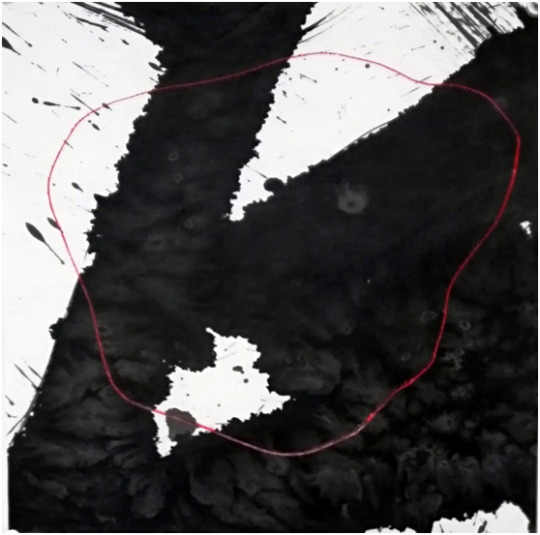
Qin Feng’s painting always tends to a total form, meaning by this the achievement of a correspondence between feeling and visual form. The artwork never represents the condition of the fragment, of a detail that navigates separated from a system of the whole. The whole is the result that continually achieved by the artist, armed with a vital sensitivity that always leads him to the condition of the demiurge.
This explains the challenge to abstract language, since it is sustained by a space-time delirium which always brings him to establish the essential conditions appropriate for each specific construction.
The artist employs the dual sentiment of nostalgia and of fear, leading him to establish the Nietzschean pathos of distance with language, the only reality upon which and through which he can build his own image. Nostalgia towards a history that appears to be increasingly separated from nature and fear of the violation inherent in the experimental initiative, which alone is capable of bringing it back to the foundation through the form of a natural sentiment.
But all of Qin Feng’s forms have the strength to withstand even beyond all reference, abstract pieces of matter and colour–black and white –which withstand by internal autonomy beyond all the dictates of memory. Hence the titles of the works, which respond only to the economy of artistic fantasy.
The desire for power that sustains the Chinese artist’s creativity waylays the possibility of considering the artwork as a mere relic of the fantasy, a metaphorical detail removed from a hypothetical totality. The distance permits the detachment necessary to strengthen language in its potential intensity. The pathos is inherent in the artist’s awareness of developing a struggle that can lead language to a formal status which would have been absolutely inconceivable before his intervention.
The work of the Chinese artist merges a total time encompassing the initial moments of life and the final moments of death, terms also belonging to man’s destiny. Within the tension between life and death, present and past, Qin Feng finds the time of the resurrection of language capable of founding the heroic sense of an image build upon its skeleton. Here there is no decaying appearance of the flesh, but the juicy and essential skeleton of a language enduring over time. Hence the freedom of art, its expansion into a great era of peace.
This painting does not loom over man but proposes coexistence, accompanying him within and beyond daily life, like an existential state rendered visible and silently insinuated into the bare dimension of existence.
“Never cause shame to others” Nietzsche taught us. Art places itself outside the logocentric pride of the Western painting, almost always based on the skill of technique and execution, on the superiority of a procedure and a product that is simply astonishing.
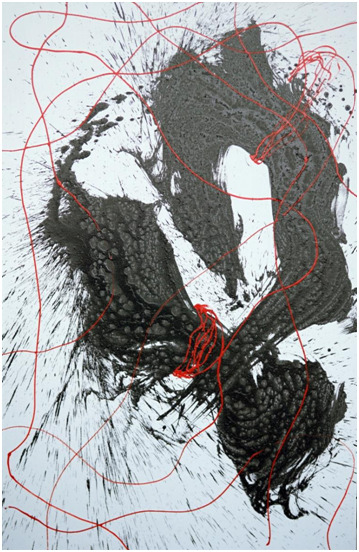
This is a precious operation by the Chinese artist, garbing the mute wall with the chromatic sound of a travelling and nomadic painting, which touches places in many countries without ever losing its own identity or cadence. Like music, it can be played anywhere, in its stainless flexibility and incessant capacity for dialogue. The artist has worked on the types of dome and frame, mentally absorbing the places surrounding him. In this way what is generated is an aesthetic expansion of painting capable of living inside and outside, within social attention and social distraction, in the frontality or laterality of the gaze.
In short, the Chinese abstract painter creates a frontier between art and life, a hinge for the social gaze that can oscillate between the inertia of the everyday and the intensity of the aesthetic sphere in a movement of delicate continuity. This is the secular aspect of an incessant and febrile work which can be applied to large and small format, in the awareness of an excellent and magnanimous gesture that can create a short circuit between the self of art and the we of the world.
The Chinese abstraction gathered together in this exhibition illustrates a major emancipation from the influences of other cultures, since it develops a position that is not subordinate to them but is nomadic and dynamic. Qin Feng’s research therefore, goes beyond all permanence within his own cultural territory, experiencing a dialectic relationship with the artistic production of other countries. Between Tao and Zen, vertigo and calmness, vertical and horizontal, Qin Feng’s abstraction ruptures the vision of Western perspective that imposes a single point of view, opening up instead to a multiple vision which is in eternal movement.
Because the Chinese vision is based upon the circular Tai Ji symbol which has no beginning and no end, developing an
image of the world that is spiritual and without hierarchies. While the Western viewer looks at a painting from a single
point of view, there is no doubt that an ancient or modern Chinese reader opening a scroll of paintings will look at it as
he walks. This is the art of Qin Feng, an art in joyful movement.
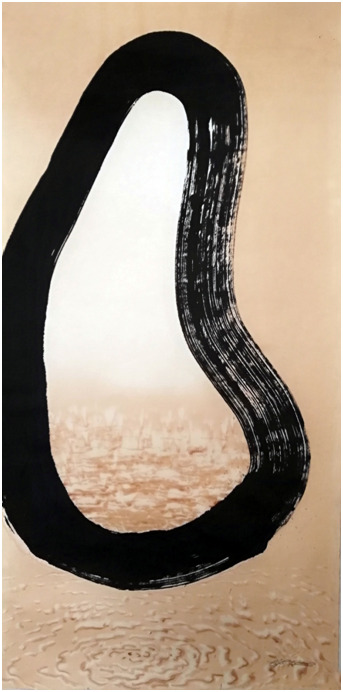
1 note
·
View note
Photo
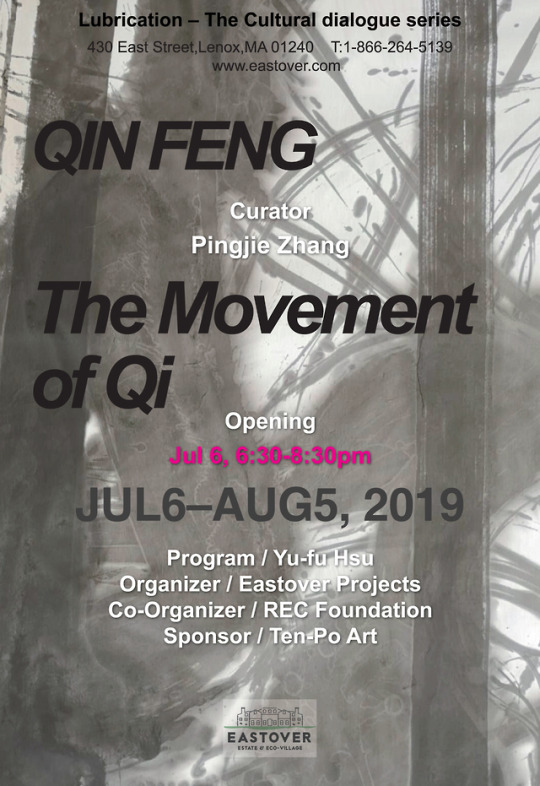
QI FENG; THE MOVEMENT OF QI
Opening: 6:30-8:30pm JUL 6, 2019
Venue: Eastover Eco-Village
1-866-264-5139. 430 East St. Lenox.MA 01240
0 notes
Text
About Zhang Zhaohui: Comments and Resume

Richard Vine Art Critic, Managing editor of “Art in America” Author of “New China, New Art”
Zhang Zhaohui’s signature accomplishment is to bring all these varied, and often conflicting, associations together in solidly composed abstract works that have an eidetic effect on the viewer’s mind. Quantum physics and Song Dynasty landscapes, fleeting impressions and enduring substructures, the cosmological and the microscopic, nature’s linear changes and its cyclical stasis, diffuse illumination and focused, penetrating beams—all these and more are encompassed in Zhang’s art. This painter considers ink art a key contemporary mode of artmaking. So what does he depict? Only infinity—and its minutest details.

Robert C. Morgan Art Critic, Art Historian, Curator, Poet and Artist
Zhang Zhaohui’sLight Infinity Series opens our visible consciousness to a type of abstract visual vibration, elegantly mannered and focused on central imagery. His grids buckle, twist and turn through space, directing our eye toward a central source of light. Inevitably, Zhang’s ink paintings rest on his expertise in constructing optical forms through linear patterns that suggest “infinity” insofar as these grids might open new doors to perception. His work focuses on the geometric in contrast to the intuitive, or possibly an overlay between the two. I have never quite understood why geometry should not be used in an intuitive way. Zhang appears to understand this. That artist’s use of geometry has the option to follow its own logic or to move into realm of the imagination. On the other hand, they have the option to do both. His ink paintings do precisely this

PING JIE ZHANG Art Critic, Curator, Scholar and artist
If we reduce Zhang Zhaohui’s work to minimalism’s hard lines, even if it keeps the purity of gray, it becomes a third party, indifferent from lacking its spiritual and emotional components. Zhang’s works have built an entanglement ofdivinity and humanity, an integration of sensibility and rationality, and a convergence of abstract space and inner world, transcendingthe consensus of culture, geography and race.
Compared with the optical effects of rational light, that is often straightforward, dazzling, solitaryand stimulating, Zhang’s light is richer, more delicate, multi-dimensional and Oriental. Look at its modality: sometimes as solemn and silence; sometimes as flyingbetween construction space; sometimes as lingering gentle; sometimes as sharp and direct; sometimes as a meteor passing by; sometimes as undulating ripples.
This is not deliberately showing or depicting light, but a sequence of gray and a spatial tracethat different rhythms and dimensions left behind. In respect to aesthetic characters of Chinese art, it is necessary to have both water and brush in the gray. Water marks by a brush are essentialelements to a painting’s structural frame, structure is not ink, but strokes. In the New York school of painting, strokes and ink (black) are confounded as one; in Eastern ink, light ink (gray) strokes can alone become the mainstay of a picture.
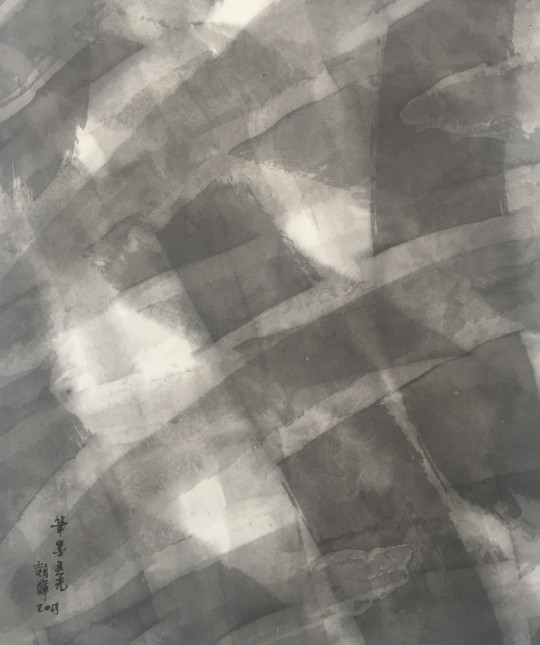
Zhang Zhaohui scholar, writer,and artist based in Beijing
Born in 1965, Hebei
1988 graduated from Nankai Univesity, Tianjin, Museum Studies in Art History 1995 Graduated from Graduate School of China Art Academy, Beijing, MA degree 1998 Graduated from Bard College, Curatorial Studies in Contemporary Art, New York,MA degree 2003-2006 Central Academy of Fine Art, Beijing, Contemporary Art and Culture,PhD program,
Fellowship and grant 1996 Asian Cultural Council 1998 Curatorial Studies 2004 Asia Link。 2014 1st Nanjing International Art Festival, Silver Medal
Working experience 1988-1995 National Museum of Art, Beijing, assistant curator/curator 1998-2000 He Xiangning Art Museum, Shenzhen, direcotr of exhibition section 2001-2002 Xray Art Center, Beijing, founder and director 2002-2005 Asia Arch Archive, Hong Kong, researcher
Public Collections Art Institute of Chicago, Fukuoka Asian Art Museum, The Macao Museum of Art, Inside-Out Art Museum,Beijing Deji Art Museum,Nanjing, Avant-Garde Contemporary Art Center, Jiangsu, Baijia Lake Art Museum, Nanjing, Asian Art Research House, Chicago.
Exhibitions 1988 Solo show, library of Nankai University 1992 Group show of artists affiliated to Cultural Administration. National History Museum, Beijing 2009 You & Me, Joey Chang Art, Beijing 2009 Erotic Make Shangdong Oil-painting Gallery, Jinan 2009 60-70-80 Chinese Contemporary Art Chateau de Tours, France 2009 360 Degree Studio Rouge Shanghai 2009 Fantasy, Sunshine Art Center Beijing 2010 Nord Art Festival, Germany 2011 10 Ink Painting Artist Story, Duolun Art Museum, Shanghai 2011 10th Pucheon International Performance Festival, Seoul 2011 Origin of Time, Ink Painting Art Museum,Shanghai 2012 Narcissus beyond the Myth, Being 3 Gallery, Beijing 2012 New Chinese Currency, Ethan Cohan Fine Art, New York 2012 Take Out,Varley Gallery of Art, Toronto 2012 Ink Painting Biennale, Dafen Art Museum, Shenzhen 2012 Ink Painting from China, Kyoto Art Museum,Japan 2012 Linzhou Ink Painting, Linzhou Art Museum 2012 Documentaries of Chinese Performance Art 2012, Macao Museum of Art 2012 Mind Natural, DYJ Lifestyle Gallery, Beijing 2012 Spirit of Nature, Red Gate Gallery, Beijing 2012 1st Milan Biennale of China-Italian Art, Milan 2012 Asian Art Festival,Toronto 2013 New Noah’s Ark,DYJ Lifestyle Gallery, Beijing 2013 Because Mountains, Imagine Gallery, Beijing 2013 Spirit of Nature, Hakkokai Gallery, Beijing 2013 Light Infinite, Design Art Space, Beijing 2013 Nord Art Festival, Kunst in der Carlshutte, Budelsdorf, Germany 2013 Parallel Experiment: Solo Show, Jianxin Art Gallery, Beijing 2013 Play With Ink Brush, Jinan Art Museum,Jinan 2013 National Abstract Art, Zhejiang Art Museum, Hangzhou 2014 Takeout, Surrey Art Gallery, Vancouver 2014 New Year Group Show, Shangshang Art Museum, Beijing 2014 Ink Light: Solo show, PennisulaHotel, Beijing
2014 Mountain and Water: Solo Show, Fukuowa Asian Art Museum, Japan 2014 The Threads that Connect Us, solo show, Red Gate Gallery, Beijing 2014 2nd China-Italia Biennale 798 Art Zone, Beijng 2014 Ethereal Dimness: New Water Ink Research Series, Avant-Garde Contemporary Art Center, Nanjin 2014 Solo Show: Linear Brightness, Tianbao Art Center, Taiwan 2014 Nanjing International Art Festival, Nanjing 2014 International Project-IN/OUT Source, Art Museum of Nanjing University of the Art, Nanjing 2015 Yuan Yi, Chinese New Abstract Art Exhibition,Shenzhen 2015 Solo Show, The Light of Heaven, Being 3 Gallery, Beijing 2015-2016 In Riotous Profusion – The New Possibilities of Ink Art Beijing, Brussels, Chicago, Taiwan 2015 Abstract Art and Its Chinese Reference, ARS Space, Beijing 2015 3rd China-Italia Biennale, Turin 2015 Painting the Present, Capri Island, Italy 2015 Annual Contemporary Art Documenta 2014, Minsheng Art Museum, Beijing 2016 An Ink Trio of Abstraction, The Research House for Asian Art, Chicago 2016 Black 3+4, Wanying Art Museum, Shijiazhuang 2016 4th China-Italia Biennale, Beijing 2016 Grand National Ink Art Show, Weihai Art Gallery, Shandong 2017 Maximalism Ink, Common Art Center, Beijing 2017 Curitiba Biennale, Oscar Niemeyer Museum, Brazil 2017 Shanghai Urban Space Art Season, Shanghai 2017 The Polars, New InkWash Painting Series Exhibition, Hongkong 2018 Sense of Paper, Melting Point, Shanghai 2018 Annual Contemporary Art Documenta 2017, Minsheng Art Museum, Beijing 2018 Summer Holiday, Contemporary Art, ERYI Gallery, Beijing 2018 A City to Wear 2.0, Research House for Asian Art, Chicago 2018 solo show, Sky Light, ANYI Gallery, Shanghai 2018 solo show, Light and Fantasy, ICI LABAS Gallery, Beijing 2018 solo show, Light of the Century, Bennet Media Studio, New York 2018 solo show, The Longitude and Latitude of Ink, GalwayArt, Hangzhou 2018 the Direction of Inkwash, Autumn Water Space, Shanghai 2018 New Contemporary Abstract Art Exhibition, ENLAI Gallery, Beijing

0 notes
Text
Zhang Zhaohui: LUBRICATION The opening ceremony
6:30-8:30 pm May 25,2019 at Eastover Eco-Village
Curator: Ping Jie Zhang
Program Director: Yu-fu Hsu

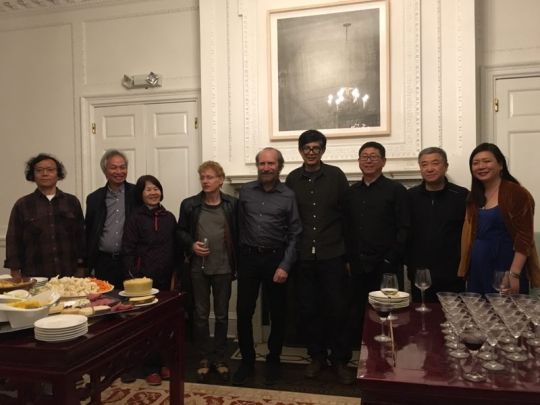

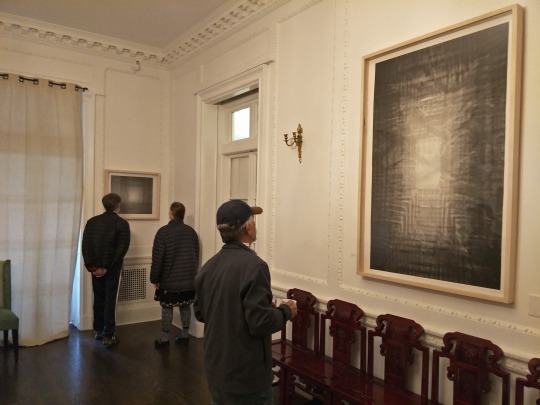




Duration: May 25th–June 30th2019
Gallery Hour: 10:00am-6:00pm
2 notes
·
View notes
Photo

Zhang Zhaohui:Lubrication
Opening: May 25th 2019, 6:30– 8:30pm
Venue: Eastover Eco-village
Add: 430 East St. Lenox MA 01240
Tel: 1-800-264-5139

0 notes
Photo

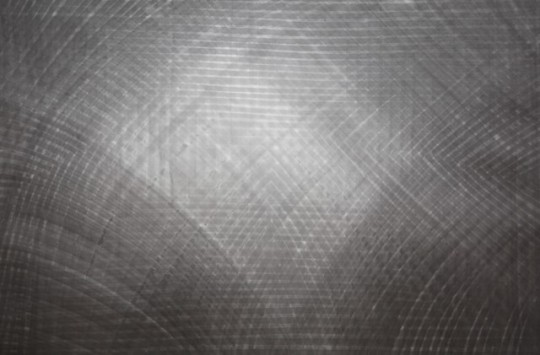
Press Release
Curator: Ping Jie Zhang
Program Director: Yu-fu Hsu
Exhibition title: Zhang Zhaohui: Lubrication
Opening: May 25th 2019, 6:30– 8:30pm
Venue: Eastover Eco-village
Add: 430 East St. Lenox MA 01240
Tel: 1-800-264-5139
Zhang Zhaohui:Lubrication
Zhang Zhaohui is a mid-career, Beijing-based artist, who has been deeply involvedin the curationand practice of Chinese art over the last three decades. Zhang studied traditional Chinese ink painting and calligraphy during his childhood, with the desire to become an artist. His education at NanKai University in the Museum Studies program in allowed him, in 1988, to acquire the position of assistant curator at the National Museum of Fine Art. During his 7 years of service at China’s top art institution, he acquired a great deal of first hand experience observing the ongoing Avant Garde art movement and numerous traveling international exhibitions.
In 1995, a grant from the Asian Cultural Council brought him to study curatorial practices at Bard College in up-state New York. Around the turn of the new millennium, he returned to Beijing to start his new career as a freelance curator and independent artist. In 2006, he quit the Art History PhD program at CAFA (Central Academy of Fine Art), and devoted himself to the reinvention and transition of ink painting into a new expression of Chinese contemporary art.
Over the last decade,China’s art world has witnessed the emergence of contemporary ink art. Zhang Zhaohui is one of the leading practitioner sactive on this new horizon of Chinese art. Based on his in-depth research of traditional art history and theory as well as modern and contemporary art, Zhang gradually developed his own art language. This is a new style of Chinese ink painting with “selected elements of Western modernism, thus producing a hybrid form that revitalizes his culture’s single most representative medium”. His repertoire is an organic integration of abstract, optical, and minimal elements, with ink-on-rice-paper, refreshing the ideologically charged stereotypes of Chinese contemporary art.
The upcoming solo show, entitled Lubrication, is Zhang’s first major presentation in USA,showcasing 23 pieces over a span of 8 years. The exhibits can be roughly divided into three categories. The first, presents another worldly pristine territory, a picture of Daoism’s key tenet: the world’s automatic operation before and after humankind’s activities. These spirit-drenched landscapes remind viewers of Caspar Fried rich’s pictures of open nature, signifying a statement of the sublime. The second category is comprised of semi-abstract works inspired by poems from the Tang Dynasty (618-907 A.D). This createsa dialogue with sentimental natural surroundings, such as clouds, wind, rain, bamboo, and foliage. The third section features linear abstract works, which are highlights of the show. Patterns are constructed from different layers of ink lines with varied saturations of water, creating a grayish light,which penetrates the surface, softens conflict, and sheds a moist luminosity. All images are a study of light and shadow.
Duration: May 25th–June 30th2019
Gallery Hour:10:00am-6:00pm
Presented by Eastover Project
Co-organizer:REC Foundation
Sponsor: Ten-Po Art
www.eastover.com
https://recfd.tumblr.com
0 notes
Text
Zhang Zhaohui: The Essence of Light
By Richard Vine
At midcareer, Zhang Zhaohui is an artist fully equipped—both conceptually and technically—to infuse Chinese ink paining with selected elements of Western modernism, thus producing a hybrid form that revitalizes his culture’s single most representative medium. This creative dualism began with the painter’s education and has found its fullest expression in his art.
Zhang graduated from college in 1988 and was hired as an assistant curator at the National Art Museum in Beijing (NAMOC). During his seven years there, he worked with many international galleries, museums, and foundations, thereby gaining a firsthand acquaintance with today’s global art system and helping to bring to China shows by such figures as Gilbert & George (Britain), Pierre Soulages (France), and Antoni Tàpies (Spain). Meanwhile, within China, artistic ferment continued in the massive “China/Avant-Garde” exhibition at NAMOC in 1989, the Yuanmingyuan and Beijing East Village artist neighborhoods, stylistic movements such as Cynical Realism and Political Pop, and collectives like the New Measurement Group in Beijing and the Big-Tail Elephant Group in Guangzhou.
Zhang’s position at NAMOC was in the folk art department, dealing with rural artifacts, so he was not directly involved in “China/Avant-Garde.” But he was witness to the entire event and deeply absorbed by the attendant colloquium and other debates. As a devotee and practitioner of ink painting, Zhang wrangled personally with the question of how China’s signature art form could be reconciled with the formal disruptions of contemporary art. His quest led him to obtain an MA in art history in 1992 from the Chinese National Academy of Arts, Beijing, a school known for its emphasis on traditional Chinese arts with an admixture of Western academic-style painting.
In 1995, Zhang traveled to the United States thanks to a grant from New York's Asian Cultural Council. Soon he enrolled upstate at Bard College—a famed bastion of advanced art theory—in the program called Curatorial Studies in Contemporary Art. Duringthe summer of 1997, Zhang served as an intern at the Asia Society in New York, where art historian Gao Minglu (formerly one of the chief organizers of “China/Avant-Garde”) was in the process of curating the landmark exhibition “Inside Out: New Chinese Art,” which presented experimental work from seventy-two individual artists and groups from mainland China, Taiwan, and Hong Kong. Asked by a skeptical fellow curator if he thought that examples of ink painting belonged in the show, Zhang argued for their inclusion, saying they represented a new stage, a new adaptation, of this ancient but constantly evolving medium. His increasingly fascination with the impact of Western modernism on Asia—particularly as manifest in the works of pioneering artists like Isamu Naguchi, Nam June Paik, and Lee Ufan—led Zhang to organize a 1998 Bard College master’s thesis exhibition titled “Where Heaven and Earth Meet: Xu Bing & Cai Guo-Qiang.”
Returning to China in 2000, Zhang studied in the graduate art history program at the Central Academy of Fine Arts, Beijing, for three years (2003-06), ultimately deciding to forgo a dissertation and a secure university teaching career in favor of pursuing his own art. Having made this bold decision, Zhang immediately began to experiment. He founded the Fingers group in the 798 art district in 2008 and produced such works asYou & Me, an installation of two life-size male and female cookie-cutter-like metal forms. He used the figure outlines in photographs, shown in grids in the “Together” series, depicting visitors posing next to and inside the silhouettes—a comment on gender conformity and non-conformity, perhaps, and on the ubiquity of the bonds of family and friendship. Zhangalso created reflective Metal Man and Mirror Man suits, which he wore in one-person walking performances. In this case, the self was “protected” like a knight inside his armor—or like an everyday citizen playing one of the conventional social roles reflected in the suits’ polished surfaces. In the manner of the Mudman (Kim Jones) who began appearing in the U.S. in the 1970s or Zhang Huan wearing a meat suit in his My New York performance in 2002, Zhang the artist remained secreted within his outwardly outlandish persona.
It soon became evident, however, that Zhang’s mind and heart were set on something more contemplative. He became convinced that traditional Chinese ink paining, in all its flexibility and formal variety, could be adapted to contemporary artistic concerns, both domestic and international, thus becoming a versatile contemporary technique that embraces the global, and the perpetually new, while continuing to honor its own cultural origins. In 2009,Zhang began producing the ink-and-wash drawings of the "Soul Mountain Series,“ exquisite landscapes combining—in a dark, haunting fashion—the traditional Chinese elements of mountains, water, mist, and light. Yet there is also a hint of Edvard Munch in the oozing semi-abstraction of the interacting areas of earth and sky, in the modernist refusal to particularizetrees, rocks, vegetation, dwellings, or human figures. Clearly it is the visual and emotional gestalt of each composition—the black mountains standing solid and stark against the luminous flux of more vaporous components (fog, water, light and shade)—that matters in these works, not any obeisance to literal representation. This interplay between the eternal structures of nature, the abiding physical counterpart of laws of cosmic order and harmony, with its ephemeral daily and hourly effects of weather, seasons, water flow, and life phases—this is essential theme of Chinese ink art, caught here from a dramatic contemporary perspective.
Over time, this reconciliation of apparent contraries—timelessness and immediacy, tradition and modernity—was capsulized for Zhang in the infinitely adaptable flow of the ink line itself. During a transitional phase, around 2011, he harnessed that flow of parallel lines, varying in weight and speed, to the presentation of lexical forms (for example, the hammer and sickle, the dollar sign), implicitly commenting on the way human consciousness subject to ingrained psychology modalities and the limitations of language itself tends to translate immense political and socioeconomic complexities into simple, easily mani pulable signifiers: emblems that are iconic, fraught, almost oracular in their openness to conflicting and ever-changing interpretation.
Zhang soon eschewed that sign-language for pure linear abstraction. By 2012, he was working steadily in the style for which he is now widely known: patterns of black ink lines on paper—sometimes curving, sometimes rectilinear and crisscrossing—that evoke geometric forms and varied illumination as distantly, yet provocatively, as Agnes Martin’s grids evoke landscape. Some commentators (notably Clive Tzuang, professor emeritus, National Taiwan University, in his contribution to the symposium “Century of Light: Art and Science in the Work of Zhang Zhaohui” at Bennett Media Studio in New York in June 2018) have relatedthese patterns to scientific experiments in optics and subatomic physics: the behavior or light waves or photons when subjected to filters. We can understand how this parallel might arise. All depiction, after all, is a study of light—how it pervades the atmosphere, how it strikes objects and reflects at various frequencies to our eyes. Zhang is an intuitive artist, not a research technician, but his long examination of art—and its ways of representing the world (or, more accurately, conditioning our perceptions, both retinal and cognitive, of the world)—has taken him into the heart of light itself.
For Western viewers, one of the most puzzling aspects of traditional Chinese painting is the preternatural evenness of its illumination. To eyes conditioned by the dramatic, raking shafts of Caravaggio and the soft volume-modeling interplay of radiance and shadow in Rembrandt and Vermeer, the uniformly "flat” luminosity of much Chinese painting can be disconcerting. And so it remains until one grasps two principles: first, that these ink-and-brush images seek to convey the spiritual essence rather than the natural appearance of their subjects; second, that this calm evenness of illumination echoes a larger sense of cosmic order, a belief in the transcendent harmony of life's rhythms and cyclical changes, whether seasonal, historical, or personal.
Something like that traditional Chinese notion is manifest in the work of America’s nineteenth-century Luminist landscape painters and even in the light-drenched images of Europe’s Impressionists. Yet, in the West, there is always a countercurrent at work, because light is historically conceived by Euro-American thinkers as an active agent. In mythology, creation itself begins with the divine commandment “let there be light.” Later, brightness struggles with darkness—good against evil—in the Manichean philosophical schema. Dante, in the fourteenth century, equates lightwith God’s love, radiating outward through all the realms and levels of existence. The Illuminati regardedlight as synonymous with wisdom. In optics, it is the sum of all colors, revealed to us through a prism. In cosmology, light’s speed is the upper limit of travel: nothing can exceed it. In biology, it animates not only plants, through photosynthesis, but virtually all organic life.
Perhaps nowhere is the hemispheric cultural divideclearer than in the contrast between the Eastern meditative goal of Enlightenment, a contemplation grasp of the oneness of all things, which stands in stark contradistinction, the West’s eighteenth-century Enlightenment, a collective purging of superstition, error, convention, and faith for the sake of a ceaseless inquiry, a driving empirical rationalism. The latter enterprise is dedicated, so the speak, to the truth of particulars, to facticity over poetry.
Zhang Zhaohui’s signature accomplishment is to bring all these varied, and often conflicting, associations together in solidly composed abstract works that have an eidetic effect on the viewer's mind.Quantum physics and Song Dynasty landscapes, fleeting impressions and enduring substructures, the cosmological and the microscopic, nature’s linear changes and its cyclical stasis, diffuse illumination and focused, penetrating beams—all these and more are encompassed in Zhang's art. This painter considers ink art a key contemporary mode of art-making. So what does he depict? Only infinity—and its minutest details.
1 note
·
View note
Photo
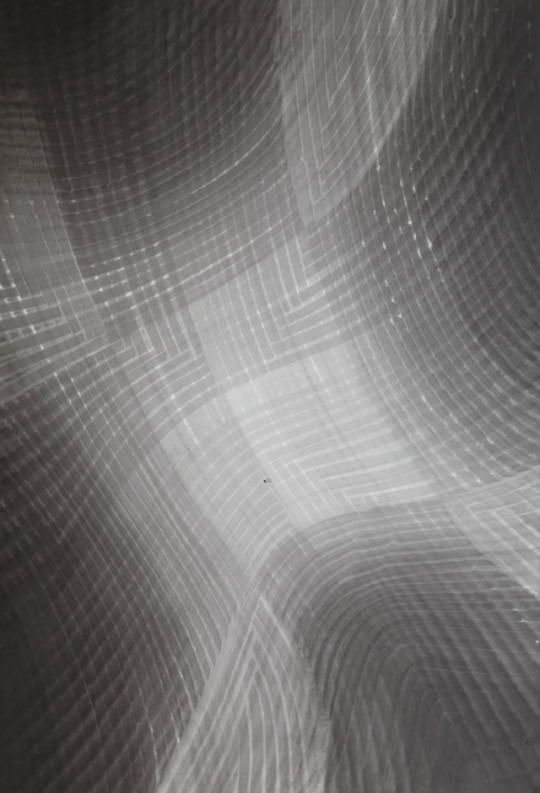
张朝晖 Zhang Zhaohui 弧光 Curve Light , Ink on rice paper 142x97cm 2015
0 notes
